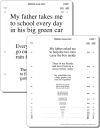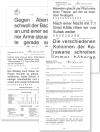Reading charts in ophthalmology
- PMID: 28411305
- PMCID: PMC5541099
- DOI: 10.1007/s00417-017-3659-0
Reading charts in ophthalmology
Abstract
A new generation of logarithmic reading charts has sparked interest in standardized reading performance analyses. Such reading charts have been developed according to the standards of the International Council of Ophthalmology. The print size progression in these calibrated charts is in accordance with the mathematical background of EN ISO 8596. These reading charts are: the Bailey-Lovie Word Reading Chart, the Colenbrander English Continuous Text Near Vision Cards, the Oculus Reading Probe II, the MNREAD Charts, the SKread Charts, and the RADNER Reading Charts. The test items used for these reading charts differ among the charts and are standardized to various extents. The Bailey-Lovie Charts, MNREAD Charts, SKread Charts, and RADNER Charts are also meant to measure reading speed and allow determination of further reading parameters such as reading acuity, reading speed based on reading acuity, critical print size, reading score, and logMAR/logRAD ratio. Such calibrated reading charts have already provided valuable insights into the reading performance of patients in many research studies. They are available in many languages and thus facilitate international communication about near visual performance. In the present review article, the backgrounds of these modern reading charts are presented, and their different levels of test-item standardization are discussed. Clinical research studies are mentioned, and a discussion about the immoderately high number of reading acuity notations is included. Using the logReading Acuity Determination ([logRAD] = reading acuity equivalent of logMAR) measure for research purposes would give reading acuity its own identity as a standardized reading parameter in ophthalmology.
Keywords: Reading acuity; Reading charts; Reading performance; Reading speed; Sentence optotypes.
Conflict of interest statement
Funding
No funding was received for this article.
Conflict of interest
W. Radner receives royalties for the Radner Reading Charts and the Oculus Reading Probe II and has served as consultant for the Oculus Cooperation during the development of this reading probe. The author has no further affiliation with or involvement in any organization or entity with any financial interest (such as honoraria; educational grants; participation in speakers’ bureaus; membership, employment, consultancies, stock ownership, or other equity interest; and expert testimony or patent licensing arrangements) or non-financial interest (such as personal or professional relationships, affiliations, knowledge, or beliefs) in the subject matter or materials discussed in this manuscript.
Figures










References
-
- Huetz WW, Eckhardt HB, Röhrig B, Grolmus R. Intermediate vision and reading speed with array, Tecnis, and ReSTOR intraocular lenses. J Refract Surg. 2008;24:251–256. - PubMed
Publication types
MeSH terms
LinkOut - more resources
Full Text Sources
Other Literature Sources
Research Materials

